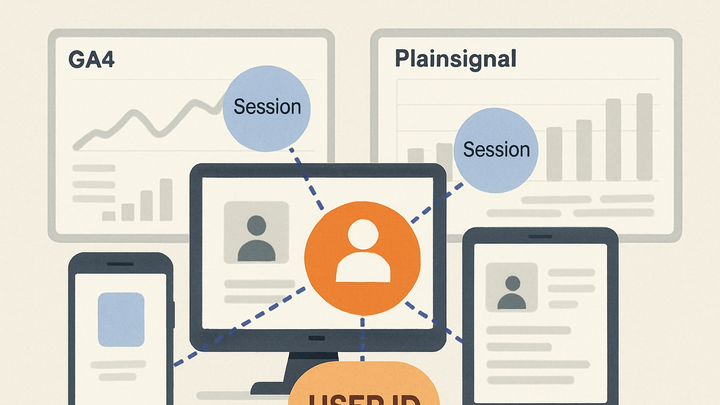Published on 2025-06-26T04:49:29Z
What is User ID Stitching? Definition and Examples with GA4 and PlainSignal
User ID Stitching is the process of merging multiple interactions from the same user across sessions, devices, and channels into a single, unified profile.
This technique is essential in modern analytics to deliver accurate user counts, cross-device attribution, and personalized experiences. By linking events to a stable user identifier—such as a login ID or server-generated token—analytics teams can overcome limitations of cookie-based tracking and fragmented session data.
There are several approaches to user ID stitching, including deterministic methods that rely on logged-in users, probabilistic techniques that infer identity from device signals, and emerging cookie-free solutions like PlainSignal that leverage first-party IDs and server-side tokens. Tools like Google Analytics 4 (GA4) provide built-in user ID features, while specialized platforms such as PlainSignal offer privacy-focused, cookie-free analytics.
Implementing user ID stitching requires careful attention to privacy regulations (GDPR, CCPA), data hygiene, and fallback strategies for anonymous users. When done correctly, it empowers teams to unlock deep insights into user journeys and behavior.
User id stitching
Combining multiple sessions and devices into a unified user profile for accurate user-level analytics.
Overview of User ID Stitching
User ID Stitching connects multiple touchpoints from the same user—across sessions, devices, and channels—into a cohesive profile. This unified view enables accurate measurement of unique users, consistent attribution, and tailored experiences.
-
Definition
Linking all events and sessions to a single, stable user identifier to track behavior at the individual level.
-
Goals
Understand user journeys end-to-end, reduce duplicate counts, and enable personalized marketing or product features.
-
Importance
Ensures reliable user metrics, empowers cross-device attribution, and supports data-driven personalization strategies.
Techniques and Approaches
There are three primary methods for user ID stitching, each with its own trade-offs in accuracy, privacy, and implementation complexity.
-
Deterministic stitching
Relies on explicit user identifiers provided at login or via CRM integration. Every event carries the same known user ID.
-
Login-based ids
Assign a unique user_id when a visitor logs in or registers, and pass it to your analytics tool.
-
Crm integration
Sync customer IDs from a CRM or database into server-side tracking to unify offline and online interactions.
-
-
Probabilistic stitching
Infers user identity by matching device and behavioral signals (e.g., IP, user agent, click patterns). Less precise but can cover anonymous users.
-
Device fingerprinting
Combine browser and device attributes (screen resolution, fonts, timezone) to create a pseudo-unique fingerprint.
-
Behavioral matching
Use session timing, navigation patterns, and engagement metrics to probabilistically link sessions.
-
-
Cookie-free stitching
Emerging approach that avoids traditional cookies by using first-party IDs, hashed data, or server-side tokens. PlainSignal is an example of a cookie-free analytics platform that supports this.
-
First-party ids
Store a stable identifier in local storage or custom headers instead of third-party cookies.
-
Server-side tokens
Generate and manage user tokens on your server to maintain privacy compliance and control.
-
Implementation Examples
Below are code snippets demonstrating how to initialize and send a user ID in PlainSignal and Google Analytics 4 (GA4).
-
PlainSignal
Use PlainSignal’s cookie-free script to initialize analytics and set the user ID once the visitor is authenticated.
-
Initialization
<link rel='preconnect' href='//eu.plainsignal.com/' crossorigin /> <script defer data-do='yourwebsitedomain.com' data-id='0GQV1xmtzQQ' data-api='//eu.plainsignal.com' src='//cdn.plainsignal.com/plainsignal-min.js'></script> -
User id injection
<script> // After user login PlainSignal('user', { id: 'USER_ID' }); </script>
-
-
Google analytics 4 (GA4)
Leverage GA4’s user_id parameter in your gtag.js configuration to stitch sessions to the authenticated user.
-
Gtag initialization
<!-- GA4 gtag.js snippet --> <script async src='https://www.googletagmanager.com/gtag/js?id=G-YYYYYYY'></script> <script> window.dataLayer = window.dataLayer || []; function gtag(){dataLayer.push(arguments);} gtag('js', new Date()); gtag('config', 'G-YYYYYYY'); </script> -
User id configuration
<script> // Set the user_id for signed-in users gtag('config', 'G-YYYYYYY', { 'user_id': 'USER_ID' }); </script>
-
Benefits and Challenges
User ID stitching unlocks powerful insights but also introduces considerations around privacy, data quality, and complexity.
-
Benefits
- More accurate unique user counts
- Improved cross-device and cross-session attribution
- Enhanced personalization and targeted marketing
-
Challenges
- Privacy and compliance (GDPR, CCPA) requirements
- Complexity of managing and deduplicating identifiers
- Gaps when users don’t authenticate or clear storage
Best Practices
Adopt these guidelines to implement user ID stitching effectively, ethically, and reliably.
-
Privacy and compliance
Always hash or anonymize any PII, honor opt-out signals, and ensure your implementation complies with GDPR, CCPA, and other regulations.
-
Data hygiene
Verify consistent ID assignment, remove or expire stale identifiers, and monitor for mismatches across systems.
-
Hybrid approach
Combine deterministic, probabilistic, and cookie-free methods to maximize coverage and accuracy while respecting user privacy.
